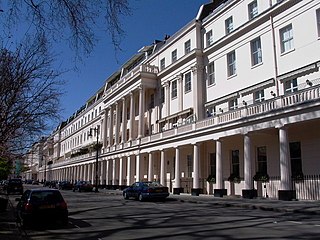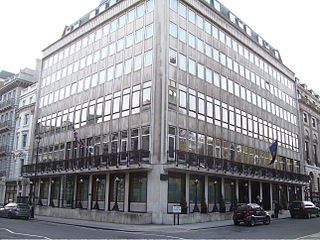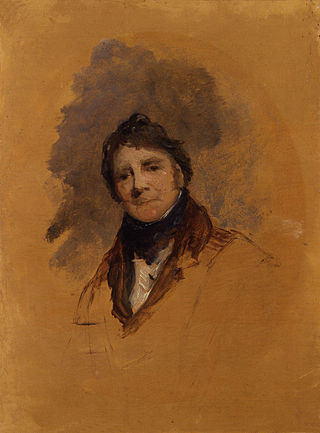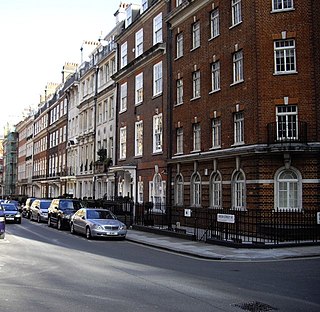
Mount Ararat was a large country house at Richmond Hill in London, built in the 1740s and demolished circa 1897. It was occupied by a field marshal and later by an admiral.

Mount Ararat was a large country house at Richmond Hill in London, built in the 1740s and demolished circa 1897. It was occupied by a field marshal and later by an admiral.
The house was built in the 1740s for Thomas Warren and was originally occupied by Daniel Wray, a trustee of the British Museum. [1] By the early 1840s it was being used by Henry Hawkes, a gentleman of independent means, and by the late 1840s it was occupied by Field Marshal Thomas Grosvenor. [2] The house remained in the hands of the Grosvenor family after the field marshal's death in 1851 until it passed to Admiral Robert Stopford who was living there by the early 1870s and remained there until his death in 1891. [3] The house was demolished circa 1897. [4]

Admiral of the Fleet is a five-star naval officer rank and the highest rank of the Royal Navy, formally established in 1688. The five-star NATO rank code is OF-10, equivalent to a field marshal in the British Army or a Marshal of the Royal Air Force. Apart from honorary appointments, no new admirals of the fleet have been named since 1995, and no honorary appointments have been made since 2014.

Field Marshal Sir George Howard KB, PC was a British military officer and politician. After commanding the 3rd Regiment of Foot at the Battle of Fontenoy in May 1745 during the War of the Austrian Succession and after commanding that regiment again at the Battle of Falkirk Muir and the Battle of Culloden during the Jacobite Rebellion, he returned to the continent and fought at the Battle of Lauffeld. He went on to command a brigade at the Battle of Warburg during the Seven Years' War. He subsequently became the Governor of Minorca.

Grosvenor House was one of the largest townhouses in London, home of the Grosvenor family for more than a century. Their original London residence was on Millbank, but after the family had developed their Mayfair estates, they moved to Park Lane to build a house worthy of their wealth, status and influence in the 19th century. The house gave its name to Upper Grosvenor Street and Grosvenor Square.

Eaton Square is a rectangular, residential garden square in London's Belgravia district. It is the largest square in London. It is one of the three squares built by the landowning Grosvenor family when they developed the main part of Belgravia in the 19th century that are named after places in Cheshire — in this case Eaton Hall, the Grosvenor country house. It is larger but less grand than the central feature of the district, Belgrave Square, and both larger and grander than Chester Square. The first block was laid out by Thomas Cubitt from 1827. In 2016 it was named as the "Most Expensive Place to Buy Property in Britain", with a full terraced house costing on average £17 million — many of such town houses have been converted, within the same, protected structures, into upmarket apartments.

Cannizaro Park is a public park in Wimbledon in the London Borough of Merton. Located towards the south-western edge of Wimbledon Common, it is known for its ornamental landscaped gardens with ponds and sculpture.

Devonshire House in Piccadilly, was the London townhouse of the Dukes of Devonshire during the 18th and 19th centuries. Following a fire in 1733 it was rebuilt by William Cavendish, 3rd Duke of Devonshire, in the Palladian style, to designs by William Kent. Completed circa 1740, it stood empty after the First World War and was demolished in 1924.

Wellclose Square is a public square in the London Borough of Tower Hamlets, between Cable Street to the north and The Highway to the south.

The Army and Navy Club in London is a private members' club founded in 1837, also known informally as The Rag.
Thomas Cundy, the elder was an English architect. Surveyor to the Grosvenor family's London estates from 1821, he was involved in the initial stages of the development of Belgravia and Bloomsbury, and also designed country houses in a picturesque Gothic style.

Tyttenhanger House is a 17th-century country mansion, now converted into commercial offices, at Tyttenhanger, near St Albans, Hertfordshire. It is a Grade I listed building.

Field Marshal Thomas Grosvenor was a British Army officer. After serving as a junior officer defending the Bank of England during the Gordon Riots he took part in the Flanders Campaign including the retreat into Germany during the French Revolutionary Wars. He served as a brigade commander at the Battle of Copenhagen and was then deployed to Walcheren in the Netherlands where he served as deputy commander of a division led by Sir Eyre Coote during the disastrous Walcheren Campaign.

Field marshal (FM) has been the highest rank in the British Army since 1736. A five-star rank with NATO code OF-10, it is equivalent to an Admiral of the Fleet in the Royal Navy or a Marshal of the Royal Air Force in the Royal Air Force (RAF). A Field Marshal's insignia consists of two crossed batons surrounded by yellow leaves below the Tudor Crown. Like Marshals of the Royal Air Force and Admirals of the Fleet, Field Marshals traditionally remain officers for life, though on half-pay when not in an appointment or retired. The rank has been used sporadically throughout its history, and was vacant during parts of the 18th and 19th centuries. After the Second World War, it became standard practice to appoint the Chief of the Imperial General Staff to the rank on his last day in the post. Army officers occupying the post of Chief of the Defence Staff, the professional head of all the British Armed Forces, were usually promoted to the rank upon their appointment.

Twickenham Park was an estate in Twickenham in south-west London.

Richmond House was a large mansion in Twickenham, Surrey, England.

Peterborough House, on the south-west side of Parsons Green, near Eel Brook Common, was a London townhouse owned by the Mordaunt family, Earls of Peterborough and later by the Grosvenor family. It was the most westerly townhouse in the City of Westminster.
Whitton Park was a country house in the village of Whitton in Twickenham, Middlesex. It was demolished in the 1840s and gradually replaced with housing.

Swallow Street is a small street in the West End of London, running north from Piccadilly. It is about 341 feet (104 m) long.

South Audley Street is a major shopping street in Mayfair, London. It runs north to south from the southwest corner of Grosvenor Square to Curzon Street.

Green Street is a street in Mayfair, London. It has been built up since the mid-18th century, but most of the current properties date from the late 19th and early 20th century. It has had a number of significant residents, including various members of the British aristocracy, the James Bond author Ian Fleming, and the Beatles.